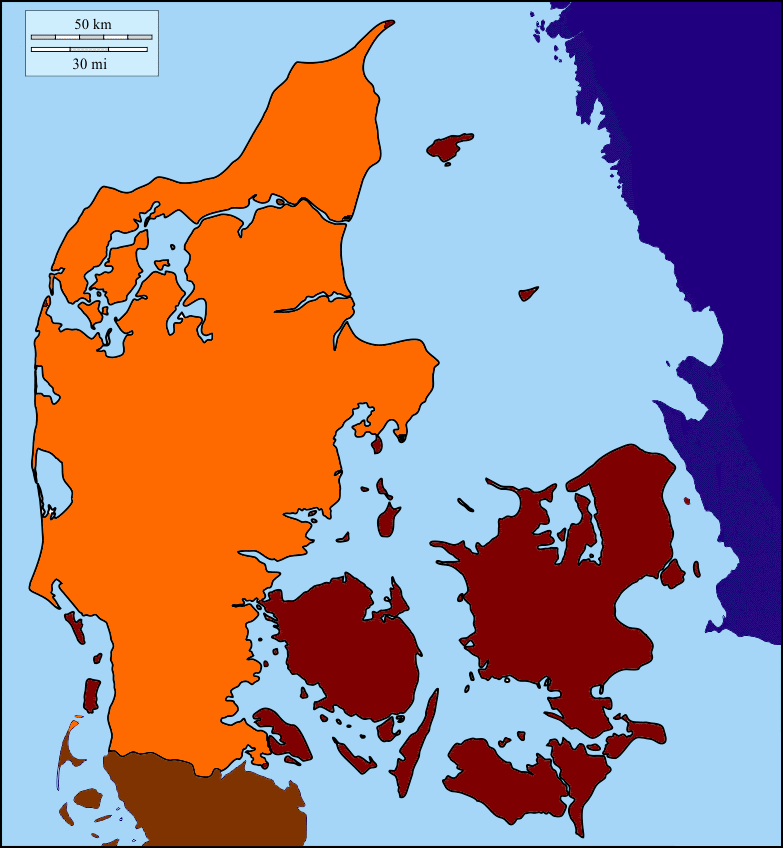Kingdom of Danerheim
Structure
The king is assisted by the royal council and the government. The royal council consists of 5 members of the high nobility, 3 members of the petty nobility, the Danerheimien cardinal, the queen (or queen mother if the king is not yet married), and all crown princes and princesses. The high nobility's advisory posts remain family-owned and will be passed on, leaving the five most powerful noble families in permanent residence at the royal court, while the posts of the petty nobility are elected every 10 years. The task of the council is to assist the King in all his decisions, but above all in questions of legislation, in an advisory and executive capacity.
The government, on the other hand, is completely appointed by the king, although it has become customary for the king to appoint the chancellor first, and the chancellor then compiles a cabinet with which he can and will work in the name of the king. Royal decrees and laws are to be carried out by this government, and it is their job to keep an eye on the finances and bureaucracy of the empire and to divide up the budget. Even though every Danerheimien citizen can be called into the goverment by the king, in reality, the government is composed almost entirely of members of the high and petty nobility, with some exceptions of urban middle class members.Although the old principalities from which the kingdom was forged still exist on paper, the high nobility just still holds on to thier titles without any direct controll over said principalities. The empire is strongly centralized, with Koppen-Haven as its economic, political and cultural center. High and petty nobility still own large parts of the farmland and some some nobles have invested heavily in trading houses and factories, whereby the nobility draws its political power from its importance for the nations economy.
History
The kingdom of Danerheim was created in 984 by King Asger "the Unifier" of Nykheim and will be 218 years old at the end of this year. The civil war between King Torb I. and King Unger IV. of Nykheim, which became known as the Great Troubel, laid the foundation for the rapid modernization of the kingdom. Owing to his zero-tolerance policy towards the nobles who were loyal to his younger brother, nearly half of the kingdome's noble families were either exterminated or had to flee into exile. The redistribution from the vacated land meant an increasing concentration of power in the hands of the king. The standing army formed in the Second Danerheimien-Pommeranien War finally freed the royal power from the loyalty of the nobility, as the kingdom no longer had to rely on thier armies.
Bonderne og Munz painting by Wil TagdakerAlthough the nobility in several uprisings tried to limit the royal power, only the peasant uprising of 1173 succeeded to push the crown to reformation. The first convocation of the Estates General and the drafting of the first Danerheimien constitution, limited the power of the king for the first time in a hundred years. In the constitution, the king had to grant certain privileges to the nobility, give up his judicial power and grant certain rights to the citizens, such as: the right to a fair trial, freedom of assembly and expression. However, in the face of the revolution in Svaden, many of these freedoms and rights were severely restricted by royal decrees. The first assembly of the Estates General painting by Vil Aseheim
Demography and Population
Religion
The overwhelming majority belong to the religion of Teuism and is a member of the Holy Church with 96%. 2% of Danerheimers are attached to various teutistic sects, of which the Children of the Cross make up the largest group with 1,2%. Another 1,8% are committed to the Cult of Blood of the Juten but are not allowed to live it out in public and many of the faithful renounce the traditional soothing offerings. The remaining 0,2% are related to other religions.Occupation
76% of Danerheimers work in the primary sector, the vast majority in agriculture. With the first signs of early industrialization, almost 6% of Danerheimers work in factories, and another 8% work in retail. At 0,87%, the Danerheimien army is the largest single employer.Birth rate
The average birth rate in Danerheim is 7 children per family, with an average of 5 reaching adulthood. However, this varies greatly from social class to social class, so the birth rate in the aristocracy is on average at 3 children, of whom 2,4 reach adulthood. Danerheim is experiencing rapid population growth, fueled by increased farmer productivity and well-funded network of Maia temples.Religion
Foreign Relations
Danerheim's only remaining ally at the moment is the Republic of Gut, which has been under the protection of the kingdom for nearly 13 years and allows the kingdom to use its harbors for the stationing of ships and troops.

Kon og Fadreland oger ale!
the Estates General (for constitutional changes)
Red - Kingdome of Danerheim
Blue - Peoples Republic of Greater Svaden
Orange - northern Juten tribes
Brown - southern Juten tribes
Distribution of ethnic groups in Danerheim
Red - Danerheimiens
Orange - Juten
Blue - Svaden
Green - Pommeraniens
Purple - indigenous population of New Danerheim
Grey - other groups
Remove these ads. Join the Worldbuilders Guild



















Comments